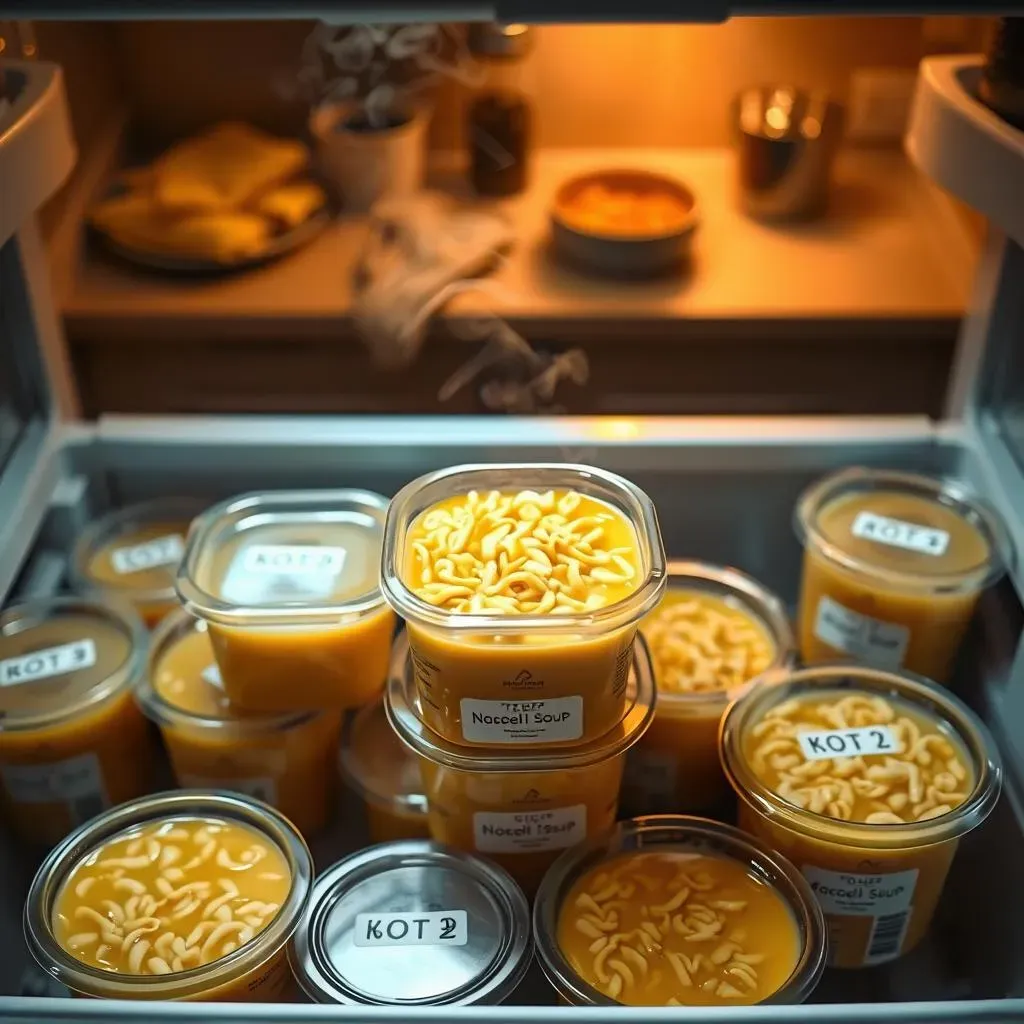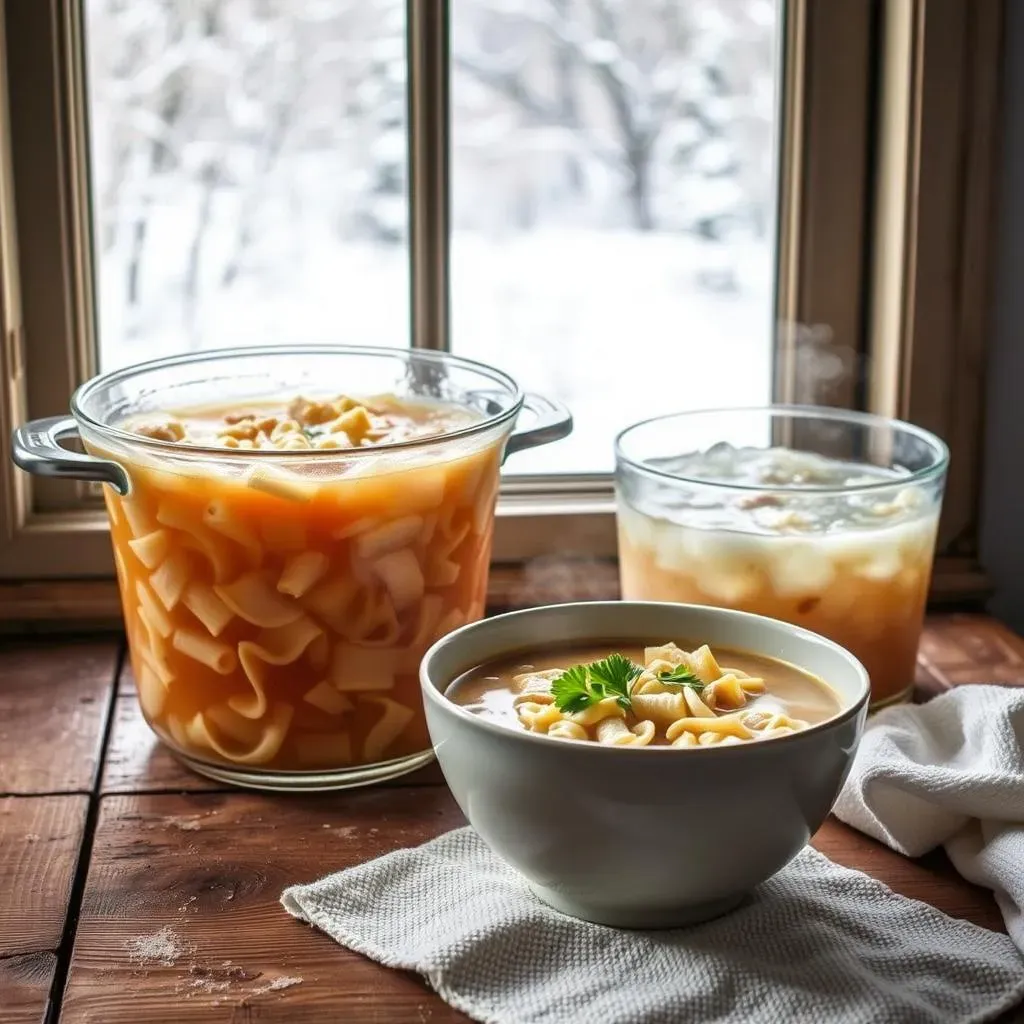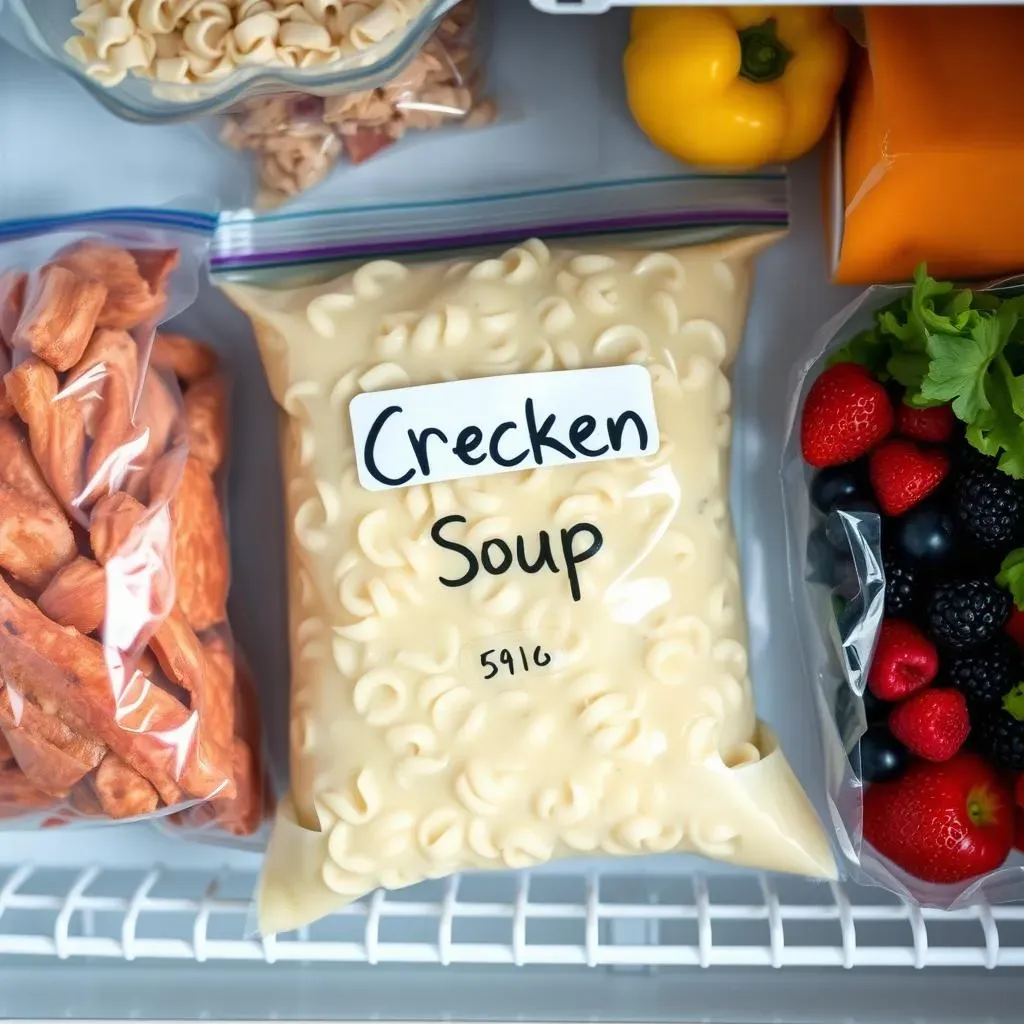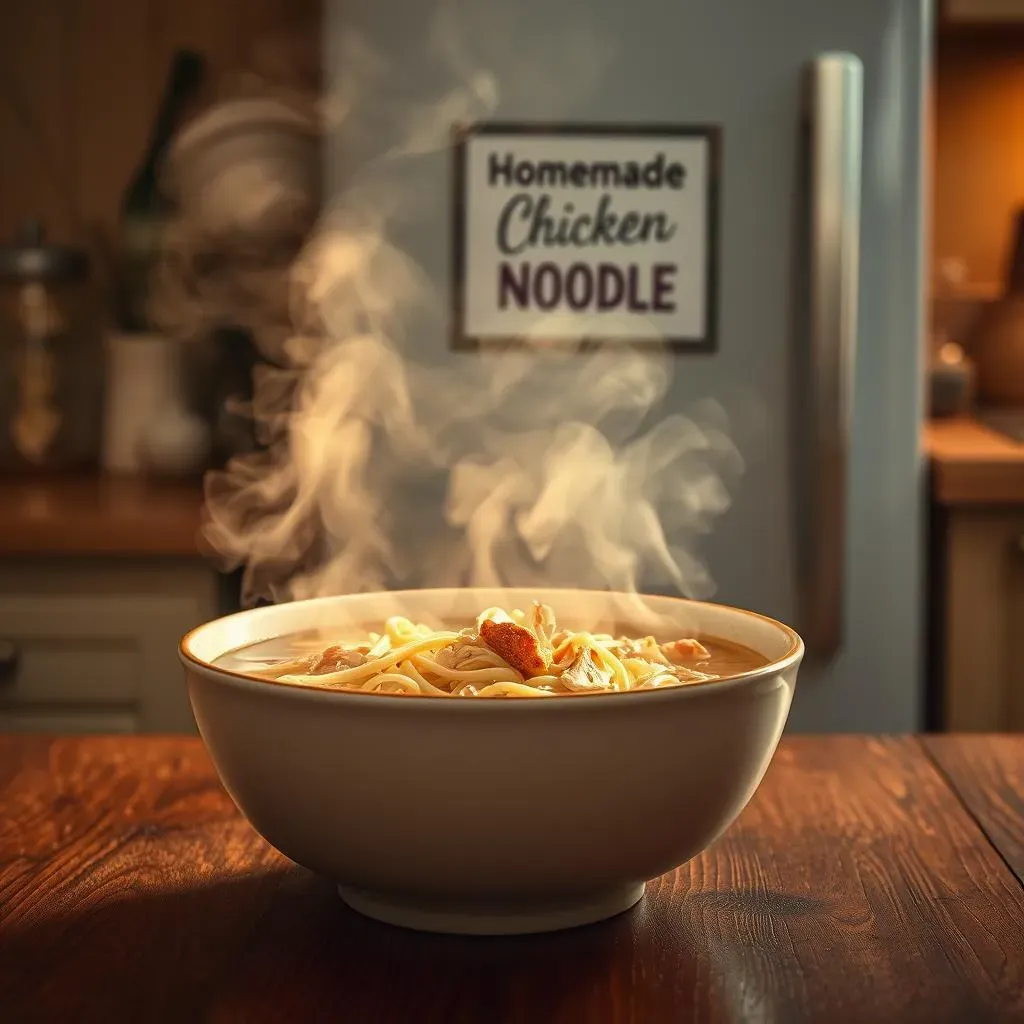Table of Contents
Ever made a huge batch of chicken noodle soup, only to realize you can't possibly eat it all before it goes bad? I've been there, staring into a pot of deliciousness, wondering if I should just give up and toss it. But what if I told you there’s a way to save that liquid gold for another day? That’s right, we're talking about how to freeze chicken noodle soup. It's not just about tossing it in a container and hoping for the best. Freezing it the right way makes all the difference between a comforting bowl of goodness and a mushy mess. This article will guide you through the simple steps to ensure your soup stays tasty and your noodles don't turn into a sad, soggy pile. We'll cover everything from the best time to add noodles, to how to thaw it properly, and even give you some pro-tips for freezing like a kitchen ninja. So, get ready to learn how to freeze chicken noodle soup and never waste a drop of that homemade goodness again!
Why Freeze Chicken Noodle Soup?

Why Freeze Chicken Noodle Soup?
Okay, so you've made a massive pot of chicken noodle soup. It smells amazing, it's comforting, but let's be real, you can't eat it all at once, unless you are planning a soup party. That's where freezing comes in like a superhero. Freezing isn't just about avoiding food waste, it's about having a delicious homemade meal ready to go whenever you need it. Think about those busy weeknights when cooking feels like a chore, or those days when you're not feeling your best and need some comfort. Having a stash of frozen chicken noodle soup means a warm, nourishing meal is just a thaw and reheat away. Plus, it's a great way to save money, since you are not tossing leftovers. It's like having a little bit of home-cooked love tucked away in your freezer, ready for any occasion. It’s a total game changer, trust me.
Freezing chicken noodle soup is also a fantastic way to meal prep. I know, meal prep can sound boring, but it's actually a secret weapon for staying healthy and organized. When you freeze a big batch of soup, you're setting yourself up for success later in the week. No more scrambling for quick and unhealthy meals. You just grab a container from the freezer, and you're good to go. I like to make a big pot on the weekend, portion it out into individual servings, and freeze them. It saves me so much time and stress during the week. It's like giving yourself a gift of time and deliciousness, and who doesn't want that?
- Convenience: Ready-to-eat meals on busy days.
- Reduces Waste: Prevents leftover soup from spoiling.
- Saves Money: Avoids costly takeout.
- Meal Prep: Makes planning easy.
- Comfort: Perfect for when you're feeling under the weather.
The Best Way to Freeze Chicken Noodle Soup (Without Mushy Noodles)

The Best Way to Freeze Chicken Noodle Soup (Without Mushy Noodles)
The Noodle Dilemma
Okay, let’s talk about the elephant in the room, or rather, the noodle in the soup. We all know that sad, soggy noodle situation that happens when you freeze soup with noodles already in it. It’s like they absorb all the liquid and turn into a mushy mess. The key here is to separate the noodles from the broth before freezing. Yes, I know it sounds like extra work, but trust me, it's worth it. Think of it like this: you wouldn’t put a wet sponge in the freezer, would you? Same concept. By keeping the noodles separate, you ensure they retain their texture and don't become a soggy, disappointing blob. This way, when you reheat your soup, you get that perfect noodle bite every time.
The first step is to prepare the chicken noodle soup as you normally would, but hold off on the noodles. Cook your broth with the chicken and vegetables, and let it cool completely. This part is crucial, because putting hot soup in the freezer can cause condensation, which can lead to freezer burn. I usually let it sit on the counter until it's lukewarm, then pop it in the fridge for a few hours to cool completely. Once your soup base is cooled down, you are ready to freeze it.
Freezing the Broth
Now that you've got your cooled soup base, it's time to get it into the freezer. You can use freezer-safe containers or heavy-duty freezer bags. I like to use both, depending on how much soup I have. For individual servings, I use containers, they stack nicely and are easy to grab. For larger batches, freezer bags are great because they lay flat, and you can stack them to save space. When using bags, squeeze out as much air as possible before sealing to prevent freezer burn. Remember, leave a little space at the top of the container or bag because liquids expand when frozen. If you fill it to the brim, you might end up with a soup explosion in your freezer, and nobody wants that.
Container Type | Pros | Cons |
|---|---|---|
Freezer-Safe Containers | Stackable, easy to grab, good for individual portions | Can take up more freezer space |
Freezer Bags | Space-saving, good for larger batches | Can be tricky to fill, prone to leaks if not sealed properly |
Adding the Noodles Later
The beauty of freezing your soup base separately is that you can cook the noodles fresh when you're ready to eat. Just boil some water, throw in your favorite noodles, and cook them according to the package directions. Once they're done, add them to your reheated soup, and voila! You have a bowl of chicken noodle soup with perfectly cooked noodles, it's like magic but it's actually just smart planning. This method makes a huge difference in the overall texture and taste of the soup when you reheat it. I remember the first time I tried this, I was blown away by how much better the noodles were. It's a small step, but it makes a world of difference. Seriously, give it a try, and you'll thank me later.
Thawing and Reheating Your Frozen Chicken Noodle Soup

Thawing and Reheating Your Frozen Chicken Noodle Soup
Alright, so you've got your frozen soup base, patiently waiting in the freezer. Now comes the fun part: bringing it back to life! Thawing and reheating might seem straightforward, but there are a few tricks to ensure your soup tastes as good as the day you made it. The key is to thaw it gently and reheat it slowly, avoiding any sudden temperature changes that could affect the texture or flavor. Think of it like waking up a sleeping giant; you want to do it gradually and with care. I've tried a few methods, and I've found that some work much better than others. Let’s walk through my go-to techniques, and I’ll share my personal experiences as well.
My favorite way to thaw frozen chicken noodle soup is in the refrigerator. It's the safest and most gentle method. Simply transfer the frozen soup from the freezer to the fridge the night before you plan to eat it. This allows the soup to thaw slowly and evenly, preventing any parts from getting too warm while others are still frozen solid. This method is perfect for when you’re planning ahead. I usually move my soup to the fridge before I go to bed, and it's ready to go the next evening. However, I know that sometimes we don't have that much time, so let's look at other options.
If you are in a time crunch, you can thaw your soup in a water bath. Place the frozen soup container or bag in a bowl of cold water. The water helps to transfer heat to the soup, speeding up the thawing process. Be sure to change the water every 30 minutes or so, to keep it cold and effective. This method is quicker than refrigerator thawing but still gentle enough to maintain the soup's quality. I've used this method when I've forgotten to take the soup out of the freezer the night before, it's a good backup option. But if you need it even faster, there’s one more method, but it comes with a small caveat.
The last method is using the microwave. It's the quickest way, but you have to be careful. Transfer the frozen soup to a microwave-safe bowl and heat it in short intervals, stirring in between. This prevents the edges from getting too hot while the center remains frozen. I recommend using the defrost setting and stopping frequently to stir the soup. This method can sometimes affect the texture slightly, but it's a lifesaver when you're in a real hurry. I use it when I'm ravenously hungry and can't wait any longer. After you have thawed your soup, it's time to reheat it.
Thawing Method | Pros | Cons |
|---|---|---|
Refrigerator | Gentle, safest, best for maintaining quality | Slow, requires planning ahead |
Cold Water Bath | Faster than refrigerator thawing, still gentle | Requires changing the water, needs attention |
Microwave | Fastest method | Can affect texture, requires careful monitoring |
To reheat your thawed chicken noodle soup, transfer it to a pot and heat it over medium-low heat. Stir occasionally to ensure even heating and prevent sticking. If the soup seems too thick, add a little bit of chicken broth or water to reach your desired consistency. I always start with a little liquid and add more if needed, it's better to start with less than to overdo it. Once the soup is heated through, you are ready to add those freshly cooked noodles. Gently stir them into the soup, and let them warm up for a few minutes. And there you have it, a delicious bowl of homemade chicken noodle soup, that tastes just like the day you made it.
Tips and Tricks for Freezing Chicken Noodle Soup Like a Pro

Tips and Tricks for Freezing Chicken Noodle Soup Like a Pro
Seasoning Smartly
Alright, let's get into some pro tips that will elevate your frozen soup game. First up, seasoning. I've learned that flavors can mellow out a bit during freezing, so it's a good idea to season your soup a little more generously than you normally would before freezing. This doesn't mean going overboard, but adding a pinch extra of salt, pepper, or your favorite herbs can make a big difference when you reheat it. Think of it like giving your future self a flavor boost. I usually taste my soup before freezing and add a little more seasoning if it seems like it could use it. It's a small step, but it ensures that your soup is bursting with flavor when you finally get to enjoy it. Nobody wants a bland, flavorless soup, right?
Also, consider using fresh herbs instead of dried ones, if possible. Fresh herbs tend to retain their flavor better when frozen, while dried herbs can sometimes become a bit muted. I love adding fresh thyme, parsley, or dill to my chicken noodle soup. It not only enhances the flavor but also adds a touch of freshness to the dish. If you are using dried herbs, make sure they are good quality and not too old. Old herbs lose their potency. You want your soup to taste amazing, and those small details matter. It's like putting the finishing touches on a masterpiece, it makes a world of difference.
Labeling and Storage
Next up, let’s talk about labeling and storage. It’s super important to label your frozen soup with the date and what's inside. Trust me, it’s easy to forget what’s in those containers after a few weeks, and you don't want to end up playing soup roulette. I use masking tape and a permanent marker to label my containers and bags, it’s simple and effective. Also, make sure to use freezer-safe containers or bags, because regular ones can crack or leak in the freezer. You want your soup to stay safe and delicious, not make a mess in your freezer. It's all about being organized, and it makes your life much easier.
When freezing soup in bags, lay them flat in the freezer until they are completely frozen. Once frozen, you can stack them to save space. This method is super efficient and it maximizes your freezer space. I always try to use the flat surface of the freezer bags to organize my freezer, and it feels so good to see everything in order. Another tip is to freeze soup in individual portions, it makes reheating so much easier and faster. You can grab a single serving for lunch or a quick dinner. It’s like having your own personal stash of homemade goodness ready to go, and who doesn’t want that?
Tip | Description |
|---|---|
Season Generously | Add a bit more seasoning before freezing to compensate for flavor loss. |
Use Fresh Herbs | Fresh herbs retain their flavor better than dried ones when frozen. |
Label Everything | Label containers with the date and contents to avoid freezer confusion. |
Freeze Flat | Lay freezer bags flat for efficient storage and quick freezing. |
Portion Control | Freeze soup in individual portions for convenient reheating. |
